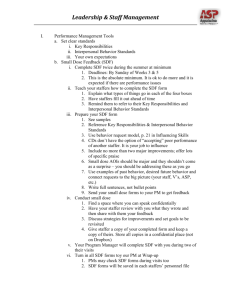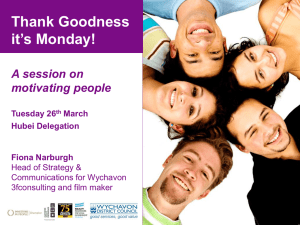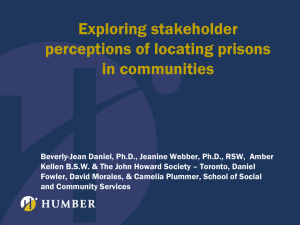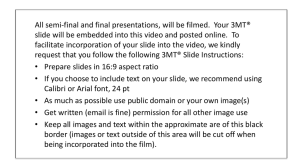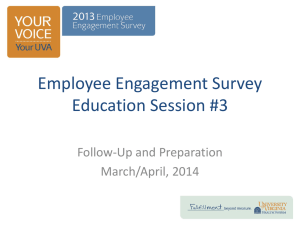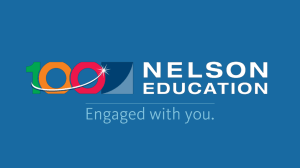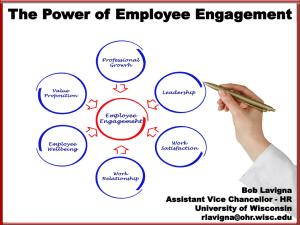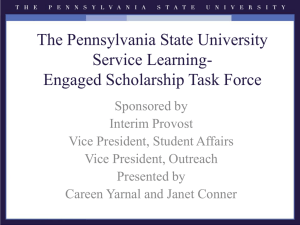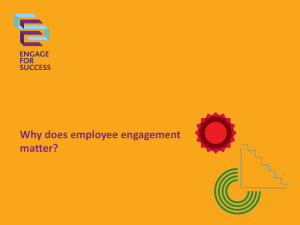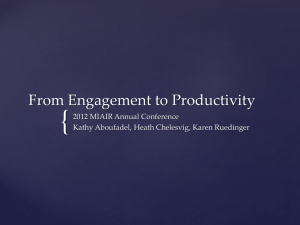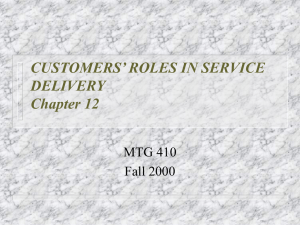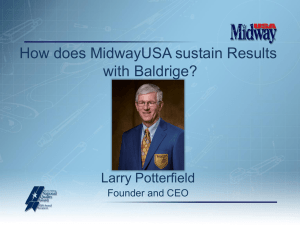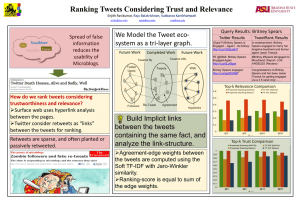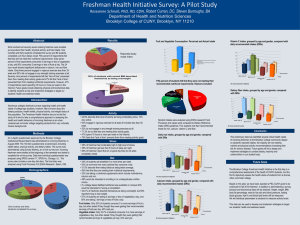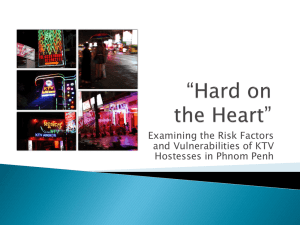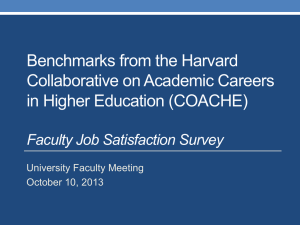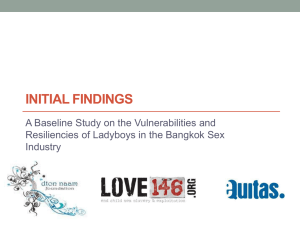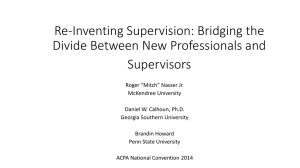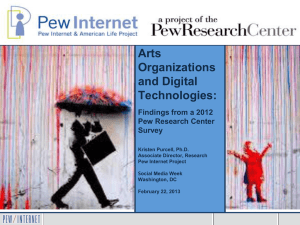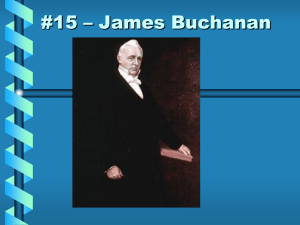employee engagement in the public sector: presentation - IPMA-HR
advertisement
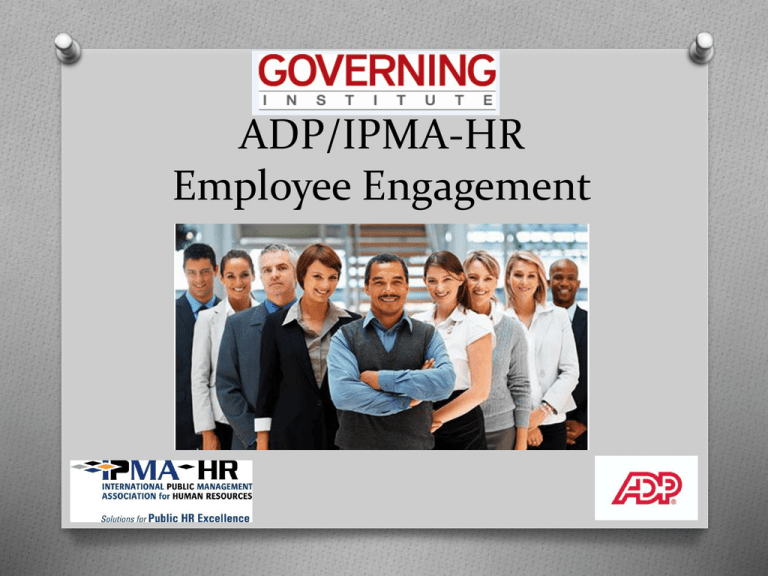
ADP/IPMA-HR Employee Engagement Methodology • • • Research study from our Governing Exchange online research community. Total sample of 2,259 state and local government employees, sample weighted by age and stratified by region, employee type, employee level, type of government: Targeted sample of 284 Senior Leaders from GOVERNING MAGAZINE Random sample of 1,975 state & local government employees across other areas of state and local of government Data collected June 21-July 13, 2012. Total sampling error of +/- 2.5 with 95% 2 confidence across N=400,000 subscribers to one or more publications. Research Program/Objectives O Qualitative research to understand the rational and emotional elements of employee engagement in the State and Local public sector. O Quantitative research to establish an employee engagement index, establish benchmarks and understand the drivers of satisfaction. O Understand best practices to improve employee engagement. O Evaluate changes in engagement over time. 3 Overall Themes From Research O Only 58% of public sector employees are fully engaged in their jobs. This number increases to 60% among HR respondents. O Serving the public with integrity was the highest rated metric calculated and the most distinguishing factor for public sector employees. O Key opportunities to improve engagement appear in the areas of Feeling Valued, Empowering employees to improve service, and Giving Recognition. 4 Overall Themes From Research (continued) O Threats to Employee Engagement: Current Workload and perceived Opportunities for Advancement undermine satisfaction and engagement at all levels of public service. O Retention Issues: one-in-seven workers are at risk generally and this number increases to nearly one-in-five for those less than 35 years of age. O Disparity in Perception: There are large disconnects in perceptions regarding employee engagement between two groups in particular: Staffers vs. Elected Officials & 34 or less vs. 55+. 5 What Is Employee Engagement? An engaged employee is enthusiastically and proudly involved in his or her organization and day-to-day job responsibilities, and engagement keeps employees committed to their work. O “A heightened emotional connection that an employee feels for his or her organization, that influences him or her to exert greater discretionary effort to his or her work.” - The Conference Board, a nonprofit business membership and research organization 6 Why Does Employee Engagement Matter? Engaged public sector employees are… O Twice as likely to stay in their current job O 2.5 times more likely to feel they can “make a difference” O 2.5 times more likely to recommend their workplace to others O Three times as likely to report being “very satisfied” in their jobs 7 Engagement Index 58% of public sector employees are fully engaged in their jobs Feel Valued Learn and Grow Serves With Integrity Understands Goals Engaged Workforce 58% Empowered to Improve * Circle size s and colors vary depending on weighted percentage. Proud to Work Here Make a Difference 8 Performance on Components Serves With Integrity 6% 92% Proud to Work Here 32% 55% Make a Difference 50% 36% Understands Goals 50% 37% Empowered to Improve Service 33% Feel Valued 31% *Learn and Grow 0% * This was a yes or no question 20% 39% Strongly Agree 39% 80% Yes 40% 60% Somewhat Agree 80% 100% 9 Engagement – Emotional Drivers I am focused on serving the public with integrity I feel I can make a difference by working here Elected Official Remote/Other 93% HR 89% 55+ 89% Average HR 99% 55+ 98% Average 98% 34 or less 97% Elected Official 95% Policy Legislature 94% 86% 34 or less 81% Staffer 78% Technology 100% 71% 0% 20% 40% 60% 80% 100% * Percentages represent number of respondents who agree with the statement. 0% 20% 40% 60% 80% 100% 10 Engagement – Emotional Drivers I feel valued here I am proud to work here Remote/Other 96% HR 95% Elected Official 93% 55+ 91% Average Elected Official 86% Remote/Other 81% HR 80% 55+ 74% 87% Average 34 or less 85% Staffer 84% 0% 20% 40% 70% Staffer 60% 80% 100% * Percentages represent number of respondents who agree with the statement. ** Very small base (n=18) 63% 0% 20% 40% 60% 80% 100% 11 Engagement – Working and Talent Tools In the last twelve months, I have had opportunities at work to learn and grow I am empowered to make decisions to improve service delivery* Senior Level (Percentage that said yes) HR 88% Elected Official 87% 91% HR 85% Remote/Other 79% Average 72% Staffer 57% 0% 80% Average 80% 35-54 64% Policy Legislature 55+ 77% Staffer 74% Technology 73% 20% 40% 60% 80% 100% * Percentages represent number of respondents who agree with the statement. 0% 20% 40% 60% 80% 100% 12 Engagement Takeaways While the strength of Serving with Integrity is nearly universal, performance on other elements varies significantly by employee subgroup: O Younger employees, staffers of all ages and technology workers are below average on “making a difference” – a key component of engagement O Staffers are on the lower end of “feeling valued” and Judicial workers really do not feel valued (small base) O Elected officials have the highest engagement, while staffers have one of the lowest scores O While more than half of public sector workers are fully engaged, less than half of younger workers (age < 35) are, making them less likely to stay in their jobs, feel they can make a difference, refer friends, and exhibit other positive behaviors. O 13 Satisfaction SWOT Analysis Strengths •Supervisor Respects Me : (55%, 28%) •Benefits Package: (50%, 36%) •Supervisor Cares What I Think: (46%, 33%) •Proper Working Conditions: (43%, 39%) Weaknesses •Supervisor Communication: (37%, 32%) •Adequately Paid: (20%, 35%) •Recognition of Effort: (25%, 36%) Opportunities •Supervisor Fosters Equality: (40%, 28%) •Innovative: (33%, 41%) Threats •Distribution of Workload: (14%, 39%) •Advancement Opportunities: (13%, 30%) * Percentages represented were for Strongly Agree or Somewhat Agree. 14 Satisfaction – Working Tools I am able to bring new and innovative ways of doing things to my workplace The workload is properly distributed HR Senior Level 67% Senior Level HR 64% 55+ 53% 34 or less 53% Staffer 51% Technology 20% 77% Average 74% 34 or less 71% Staffer 65% Technology 40% 0% 85% 55+ 59% Average 88% 40% 60% 80% * All percentages represent number of respondents who agree with the statement. 62% 0% 20% 40% 60% 80% 100% 15 Satisfaction – Communication Methods/Supervisor I receive the right amount of communication from my direct supervisor HR Supervisor- Cares what I think Senior level 85% Senior Level 78% 55+ 71% Average 69% 35-54 69% Staffer 58% 0% 20% 40% 60% 80% Remote 85% HR 84% Average 79% 35-54 77% Staffer 74% Elected official 73% 66% Technology 91% 100% * All percentages represent number of respondents who agree with the statement. 0% 20% 40% 60% 80% 100% 16 Satisfaction– Recognition/Advancement I receive recognition for the level of effort I give at work HR I have opportunities to advance here HR 81% Remote 75% Senior level 73% 55+ 63% Average 61% 35-54 59% Staffer 58% 0% 20% 40% 65% 34 or less 55% Senior level 48% Average 43% Staffer 40% 55+ 37% Elected official 60% 80% 100% * All percentages represent number of respondents who agree with the statement. 34% 0% 20% 40% 60% 80% 100% 17 Satisfaction Takeaways Workload Distribution has clearly been impacted by the economic downturn and receives one of the lowest scores across the board. Interestingly, technology workers’ scores are among the lowest on this critical element at a time when we need technology most. O Staffers and Younger workers need a greater ability to innovate in the public sector workplace. O Supervisors are the lifeblood of job satisfaction – focusing on Communications skills and Fostering equality remain areas of opportunity in supervisor skills training. O Public sector workers clearly aren’t in it for the pay, but the inability to advance is the most serious threat to the future of the public sector workforce. O 18 Career Development In the last twelve months, I have had opportunities at work to learn and grow 80% In the last six months, someone at work has talked to me about my career development progress 32% In the last month, I have received recognition or praise for doing good work *Percentage of respondents that answered yes 65% 0% 20% 40% 60% 80% 100% 19 Do you have a formal employee survey process? 3% 30% 67% Yes No Not Sure In spite of the importance of employee retention to agency success, more than twothirds of those surveyed do not have a formal process, such as employee opinion surveys or other research tools, for assessing employee engagement. 20 Career Advancement/Measurement O Public sector organizations need better tools to manage career advancement. While employees report learning and growing, more direct intervention is needed here: O Supervisors need to communicate more about this important topic and have frank conversations on what’s working, and where individuals’ career paths lie. Praise is a good start but not a substitute for a plan. O Younger workers are at greatest risk and retention efforts are needed here ASAP! O More tools are needed: job training, performance management, online learning, and workforce planning. O Every workplace should have a formal process to measure employee engagement. 21 Employee Retention Concerns They’re engaged...but for how long?? Only 31% of respondents report they were “very satisfied” with their jobs. Engaged public sector employees are 3 times as likely to report being “very satisfied” in their jobs • 28% of respondents said they weren’t likely or definitely wouldn’t recommend their department to a friend. 22 Employee Retention Concerns Cont’d How likely are you to leave if your job/working conditions do not improve within the next year? O 38% of respondents said Very likely 17% 14% 24% Somewhat likely Not likely 45% Definitely wouldn't they were either very or somewhat likely to leave their job if working conditions don’t improve, this number was dramatically higher with the “34 or less” crowd (47%). 23 How to keep us engaged Respondents have shared some best practices that work for them: “Spot bonus program for a job well done.. ” “Increased opportunities to work on projects outside normal span of responsibility.” “Started a Leadership Development Pipeline program designed to query employees on a regular frequency as to what position(s) in the organization the employee desires to achieve, along with feedback on what he/she will need in the way of education, training…” “Our exec managers have brought in a LEAN consultant and have consistently supported that effort for nearly two years. It is changing our work culture to one of innovation and improvement of processes, and in a way that has increased respect and appreciation for individuals. It succeeds because of honest communication and facilitation, not formalistic methodology.” “Individual recognition through departmental weekly newsletter. employee breakfast or lunch events sponsored by department heads collectively and paid for personally by them as a thank you to the organization.” “Motivational speaker/classes; additional benefit for counseling & stress management.” 24 Issue Brief: Employee Engagement Strategies in Action O O O O Oregon Metro and the City and Borough of Juneau (CBJ), Alaska have developed programs to help foster a more productive and engaged working environment. Oregon Metro conducts an employee satisfaction survey every other year. Metro uses performance management throughout the year to coach employees and help them develop professionally. CBJ uses a talent management process that includes talent acquisition and selection methodologies; a standardized onboarding process that lasts an entire year and includes required goals, skills and competencies; and an annual training. 25 Five Takeaways 1. 2. 3. 4. 5. Advancement is critical - provide a personalized long-term career plan for every employee and invest in people. Have a formal measurement system and use it! Tell employees what you learned and what you are going to do. Do it. A strong supervisor is a gateway to satisfaction; a weak supervisor can do great damage to engagement. Public sector employees are motivated by Making a Difference and Serving With Integrity. These are also great (and different) recruitment messages. Engage staffers (part of the future of the public sector) by allowing them to innovate and recognizing them for their good work. 26
